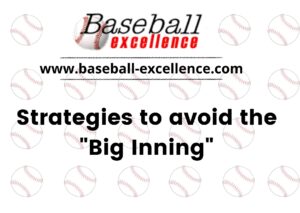Let’s talk baseball. The game is over and we want our team to stay on track and continually improve so we, as coaches are going to talk about what we did right and what we did wrong. It doesn’t matter if we won or lost, we should examine every game; not as fans but as coaches.
What do we discuss; Rickey’s error, Tommy’s strike out? Those are merely results. Let’s dig deeper.
There is usually no order. The game in all its diversity determines what you talk about; no set pattern. Sometimes I find myself going from player to player; or situation to situation. Sometimes we talk from inning to inning.
I am going to go over a game Coach Grant and I talked about recently. Hopefully what we discussed will be of interest to you and you can glean some tidbits of information from it.
We don’t take notes. We merely discuss plays as they come to us. And often one thing will lead to another. In these little “talks” we often give praise to certain players on the opposing team; their athleticism, their ability to compete, a great play here and there.
I think it’s important that coaches understand athleticism and what plays are possible in a game. Appreciating athletic ability on other teams is important so you can compare the abilities of your players.
This particular game was in a tournament in Ft. Pierce and the two teams were high school teams, we’ll call them Team A and Team B. Jack umpired behind the plate and I stood along the sidelines.
I really find this stuff fascinating. Jack has as fine a baseball mind as you will find anywhere. I never come away from a baseball conversation with him without learning something.
And baseball is like that. You digest it in small morsels. You can’t discover it all at once. It takes time. The simplicity of baseball is very beguiling; so uncomplicated and yet so complex at the same time. What a great game.
Team A
Team A’s catcher was really good. He was aware of every situation, constantly talked to his pitcher, keeping him on track and ran the game flawlessly. We admired his generalship of the game.
Their pitcher didn’t get enough first pitch strikes. Jack calls a low strike zone and their coach picked up on it right away. So he called for a lot of low fastballs. (Low, meaning that the upper half of the ball passed the lower part of the knee.) It was just that their pitcher didn’t have command enough to take advantage of it. I asked Jack how he knew the coach was aware of the strike zone and he said, “I called a strike just below the knees and I heard from their dugout, [Okay.]” When you really pay attention to the game you can pick up on little subtleties like that.
Whether you are in the stands or in the dugout if you don’t indulge in any bellyaching, whining and begging you will find that the game really opens up for you. Concentrate and try to see the entire field at once.
Team A’s third baseman was very good. I understand he has signed a letter of intent with a Division 1 College. Jack believes he will be drafted, probably quite high. Because of his range he was able to play well off the line. He made one play on a ground ball, going to his right that left my mouth open. Anything hit his way was automatic.
By playing so far off the line the shortstop could play closer to second base, giving the left side of the infield more defensive range. However, the shortstop didn’t take advantage of that and played too far in the hole, closer to the third baseman. Late in the game Team B got a crucial ground ball base hit up the middle that the SS might have defended if he was playing where he should have.
Their left fielder was a good athlete. He ran down a fly ball over his head that was a thing of beauty. He never gave up on it; something many young outfielders do. He just kept running and tracking it down. He had been taught the position. Jack asked me if any of Team B’s outfielders could have made that play. I had to say, no.
Not enough attention is paid to outfield play in practice. Oh, plenty of routine fungoes, but not enough on ‘tracking’ the ball.
Oh, Those Trick Plays
Team A likes to use trick plays and if the other team is not paying attention they will get burned. One play they like is if there is a runner on second and a fly ball is caught in the outfield. They run a sort of hidden ball trick. Both middle infielders jog in toward second base while the pitcher picks up the rosin bag as if he has the ball. (Off the mound.) Who has the ball? If the runner at second is not paying attention a middle infielder will tag him out. If the runner stays at the base they simply peel away to their positions. If you’re not looking for it you’d never know it was a play.
Team B didn’t get caught that night but later in the season when they played that team again they got a runner on second. I don’t think the team B coach knew about the play. Big out. Rally killer.
You have to see the whole field, all the time. The second you let your concentration waver, boom you’re caught. A high level of Concentration can be reinforced at practices if the coaches will Never Give In.
Like I said, Team A likes to use trick plays. The problem with that is time is wasted in practicing them; time they could use swinging the bats. They have a good program but in recent memory they have always come up short in the playoffs.
Our advice; more time on BP and less on tricks. You can’t always do both successfully. There are only so many hours available. Team A was so slick with that play that I know they must have practiced it a lot. And they have a bag full of trick plays. To each his own. Remember Clyde Metcalf’s (Sarasota HS) philosophy? ‘We try to ‘out sound’ them. We don’t try to trick them.”
Team B
The B team has several really good players; prospects, really. But they don’t do enough teaching and the average players on that team make entirely too many mistakes. Whose fault is that? It’s not the players’ fault. They made entirely too many mistakes at the third base position. Partially due to where he was setting up and partly due to faulty technique.
Team B has a great catcher this year and he really helps the pitching staff; the way he sets up late, the way he receives the ball and the way he makes his pitchers look good.
Team B had the advantage this night with first pitch strikes. They got a lot of them. When you get Strike 1, you put the hitter in more of a defensive mode.
You’ve heard us say it; “What’s the best pitch in baseball?” Fastball? Nope. Slider? Nope. Change up? Nope. The best pitch in baseball is Strike One. The pitcher is now in command and he can throw anything he wants on that second pitch.
The pitching coach has done a good job with the pitching staff on team B. He has given them a ‘Don’t give in’ attitude. They are not afraid to throw strikes. They are mentally tough in that area.
What is Your Philosophy?
Team B’s philosophy is a little different than ours. They will play a player who is not fundamentally sound on defense if he can hit. Their practices are geared almost fully to hitting. That’s okay if you do it right and work your defense in with Batting Practice. Team B doesn’t. Over the years they have benched many a player who could play defense but couldn’t hit “FOR AVERAGE.” (A philosophy born of putting too much stock in statistics.)
We take the opposite approach. Even though a team has to hit, they have to be able to play defense first. I follow Casey Stengel’s philosophy. “I never much liked them players who drove in 1 run and let in 2.”
Team B’s way of thinking will get a team to the play-offs quite often. But it won’t get them to the Promised Land. You can almost schedule a 20-win season but it takes defense to go all the way. Why? When you get to the play-offs you will be facing a very talented pitching staff, night-after night. Runs will be scarce. The team who has the best defense will win nine times out of ten. The poor defensive team will flinch every time.
Over the years Team B has had a lot of long bus rides home at the end of their season.
As a team, Team B did not like the inside fastball. They took entirely too many fastball strikes inside. And when they did swing they were not effective. Team A would throw the inside fastball when they needed an out and they got it almost every time. Team B never picked up on that.
The inside fastball is a pitch a hitter with good bat speed can really turn on and hit hard, but it has to be practiced.
As a pitching coach I have written many times about successful pitchers who throw the inside strike. Not just throwing inside but commanding the strike zone inside. If the opposing coach is aware of a team that can throw strikes on the inside part of the plate he can structure his batting practices to include working on the inside pitch. Simply set up a pitching machine and shoot balls just off the plate inside. Look for your hitters to stride at the pitcher and (not away). They can work on hand quickness and pulling the ball.
All in all for an initial game of the season the two teams played very well.
So if you are the coach of either one of those teams, what would you do to improve them? What would you do at practices? Do you see any similarities between these teams and your own?
It is very beneficial to get into the habit of critiquing games. You can do it with your coaches and with your players.
Teach and learn at the same time.




